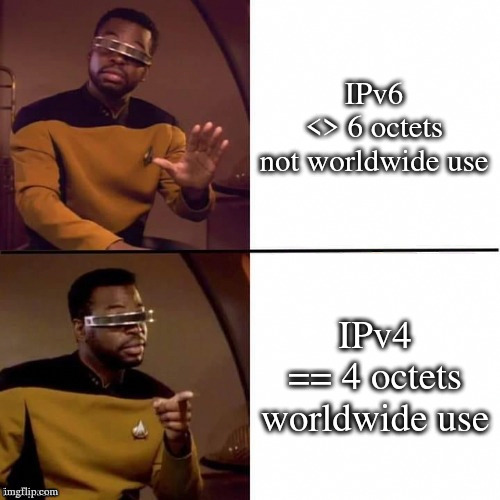this post was submitted on 19 Jun 2024
315 points (85.6% liked)
Programmer Humor
19557 readers
1029 users here now
Welcome to Programmer Humor!
This is a place where you can post jokes, memes, humor, etc. related to programming!
For sharing awful code theres also Programming Horror.
Rules
- Keep content in english
- No advertisements
- Posts must be related to programming or programmer topics
founded 1 year ago
MODERATORS
you are viewing a single comment's thread
view the rest of the comments
view the rest of the comments

I think it’s worth taking the time to learn IPv6 property. If you have a good understanding of IPv4 it shouldn’t take you more than an afternoon.
Eliminating NAT and just using firewall rules (ie what NAT does behind your back) is incredibly freeing.
I don’t get people complaining about typing out IPs. I like to give all of my clients full FQDNs but you don’t have to. Just using mDNS would be enough to avoid typing a bunch of numbers.
Maybe I have Stockholm Syndrome, but I like NAT. It’s like, due to the flaws of IPv4 we basically accidentally get subnets segmented off, no listening ports, have to explicitly configure port forwarding to be able to listen for connections, which kinda implies you know what you’re doing (ssshh don’t talk about UPnP). Accidental security of a default deny policy even without any firewalls configured. Haha. I’m still getting into this stuff though, please feel free to enlighten me
Anything connected to an untrusted network should have a firewall, doesn't matter if it's IPv4 or IPv6.
There's functionally no difference between NAT on IPv4 or directly allowing ports on IPv6, they both are deny by default and require explicit forwarding. Subnetting is also still a thing on IPv6.
If anything, IPv6 is more secure because it's impossible to do a full network scan. My ISP assigned 4,722,366,482,869,645,213,696 addresses just to me. Good luck finding the used ones.
With IPv4 if you spin up a new service on a common port it usually gets detected within 24h nowadays.
Could a hypothetical attacker not just get you to visit a webpage, or an image embedded in another, or even a speculatively loaded URL by your browser. Then from the v6 address of the connection, directly attack that address hoping for a misconfiguration of your router (which is probable, as most of them are in the dumbest ways)
Vs v4, where the attacker just sees either your routers IP address (and then has to hope the router has a vulnerability or a port forward) or increasingly gets the IP address of the CGNAT block which might have another 1000 routers behind it.
Unless you’re aggressively rotating through your v6 address space, you’ve now given advertisers and data brokers a pretty accurate unique identifier of you. A much more prevalent “attack” vector.
There is this notion that IPv6 exposes any host directly to the internet, which is not correct. When the client IP is attacked "directly" the attacker still talks to the router responsible for your network first and foremost.
While a misconfiguration on the router is possible, the same is possible on IPv4. In fact, it's even a "feature" in many consumer routers called "DMZ host", which exposes all ports to a single host. Which is obviously a security nightmare in both IPv4 and IPv6.
Just as CGNAT is a thing on IPv4, you can have as many firewalls behind one another as you want. Just because the target IP always is the same does not mean it suddenly is less secure than if the IP gets "NATted" 4 times between routers. It actually makes errors more likely because diagnosing and configuring is much harder in that environment.
That is what the privacy extension was created for, with it enabled it rotates IP addresses pretty regularily, there are much better ways to keep track of users than their IP addresses. Many implementations of the privacy extension still have lots of issues with times that are too long or with it not even enabled by default.
Hopefully that will get better when IPv6 becomes the default after the heat death of the universe.
Since you can have multiple IPv6 addresses on one machine, you can use a rotating address for all outbound connections and a permanent address for inbound connections. If you visit a malicious website that tries to attack the IP that visits it, there will be no ports open. They would have to scan billions of addresses to find the permanent address. All of that scanning would be easily detected and blocked by an IDS.
TP-Link routers used to actually do this. They didn't have an IPv6 firewall at all. In fact they didn't add an IPv6 firewall to their "enterprise-focused" 10Gbps router (ER8411) until October 2023.